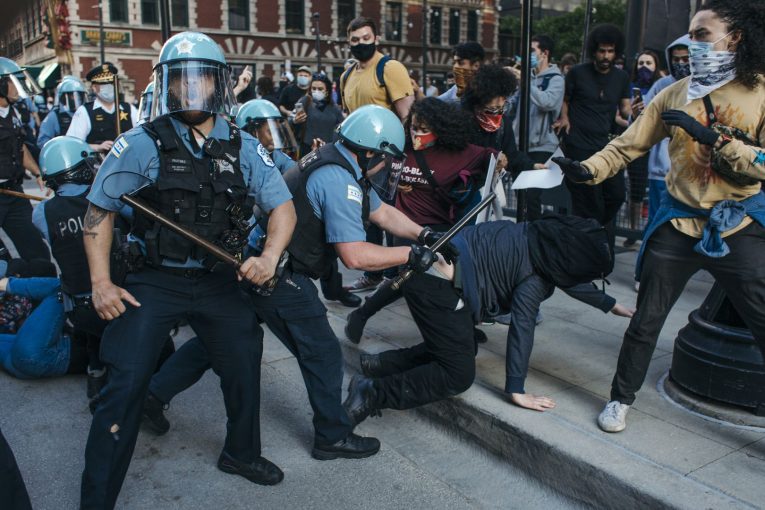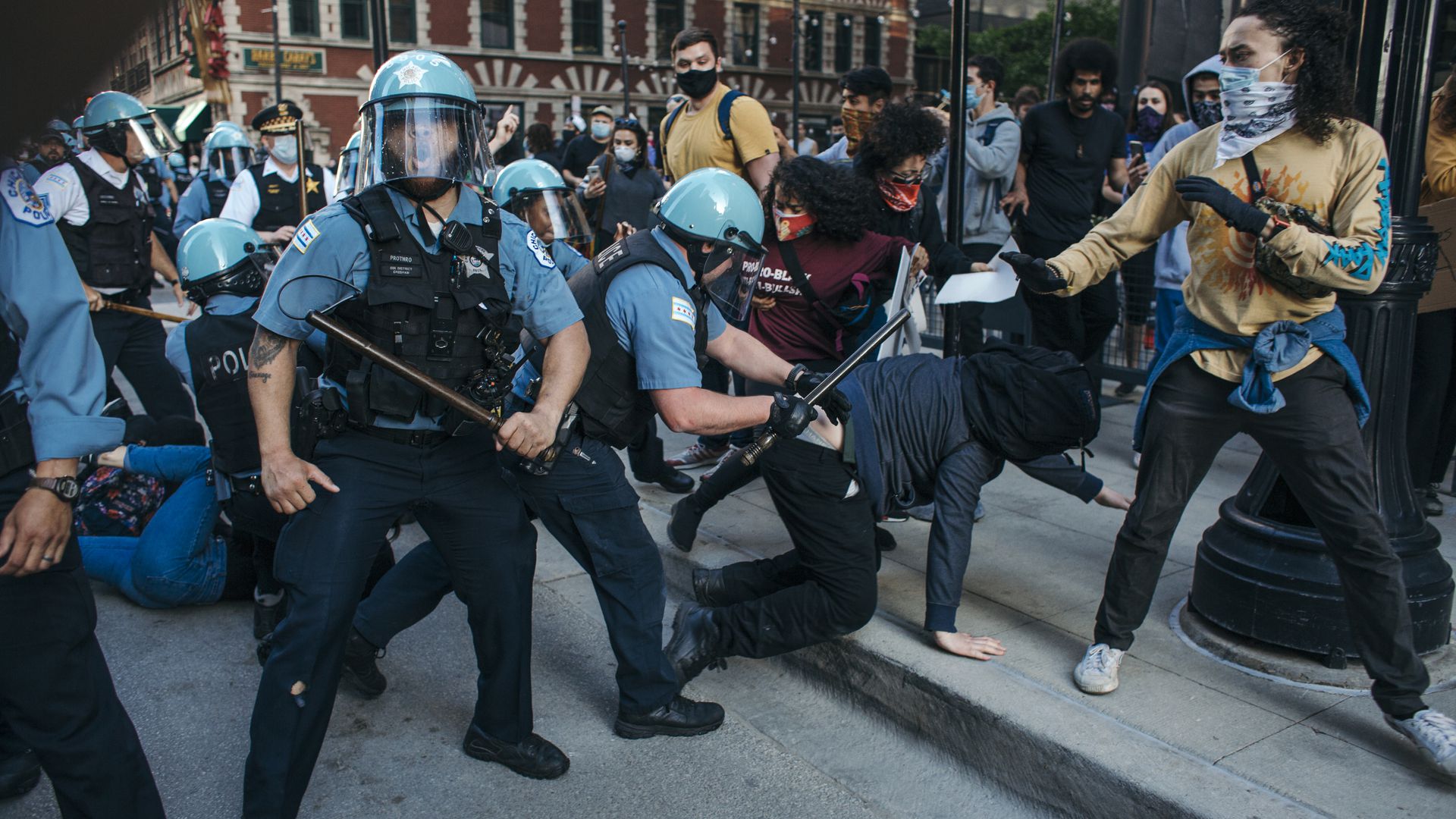

By Tanya Decendario, Esha Kher, Lisbeth Martinez
CHICAGO, IL – The Chicago Office of the Inspector General released a report last week that included a comprehensive review of the Chicago Police Dept. and the City of Chicago’s response to the protests and unrest in late May and early June in the wake of George Floyd’s death.
The report highlights three main areas of alleged breakdowns and failures: the police mass arrest process, the CPD’s shortcomings with regard to reporting obligations, and the gaps in relevant policies and structure within the Chicago Police that led to a breakdown of an accountability process.
On Monday, May 25, 2020, George Floyd was killed by the hands of a Minneapolis Police Officer. While restraining Floyd, the police officer placed his knees on Floyd’s neck, suffocating him.
A civilian filmed the incident and uploaded the video online, causing the video to spread rapidly through social media.
George Floyd’s death initiated protests and unrest across the country, including Chicago. Large-scale protests and demonstrations began to take place, some resulting in destruction of property and standoffs with the police.
Protestors called for justice for George Floyd, police reform, defunding the police, and attention to the wider unequal treatment of Black communities.
In Columbus, Ohio, about 400 protesters confronted the police and blocked an intersection. Reports said, “Protesters threw plastic water bottles, flares, and smoke bombs at the police, who  responded with Oleoresin Capsicum (OC or pepper spray) to disperse the crowd.”
responded with Oleoresin Capsicum (OC or pepper spray) to disperse the crowd.”
Seven civilians were shot in Louisville, Kentucky, after protesting the killings of George Floyd and Breonna Taylor, a woman shot by Kentucky Police Officers.
In the midst of the riots, former President Donald Trump called the protestors “thugs” and tweeted, “When the looting starts, the shooting starts.”
A 19-year-old protester was shot and killed in Detroit, Michigan.
“Polling in June 2020 suggested that between 15 to 26 million people in the United States participated in protests over Floyd’s death,” said news reports.
In Chicago, the large-scale public protest left the Chicago Police Department unprepared and ill-equipped.
“CPD’s senior leadership failed the public they are charged with serving and protecting and they failed the department’s rank-and-file members and front-line supervisors, who were at times left to high-stakes improvisation without adequate support or guidance,” said the report.
The City of Chicago Office of Inspector General (OIG) and Independent Monitoring Team (IMT) created an in-depth report of the events that occurred May 29 through June 7.
The purpose of the report is to provide an analysis of CPD and the City of Chicago’s response to the aftermath of the death of George Floyd.
OIG conducted more than 70 interviews, listened to community members, evaluated social media posts, investigated video and radio footage, and organized a quantitative analysis on CPD data.
OIG reviewed body-worn camera (BWC) footage. However, not all of the footage was available. Reporters claim that “many requests remained unfulfilled for several months, and some remain unfulfilled as of publication of this report.”
They reviewed over 100 videos of BWC footage from CPD and the Cook County Sheriff’s Office. “[They] reviewed 202 videos, totaling 83 hours of recording, which were tagged with the event number. These videos showed protest crowd control, police response to store lootings in progress, arrest, and other police actions on May 30 in CPD’s 1st and 18th districts.”
The greatest number of arrests between May 29 and June 7 was 385 mass arrests at Trump Tower and surrounding areas.
The first finding of the OIG emphasized the breakdown of the mass arrest process due to CPD’s failure “to arrest some offenders, the release of some arrestees without charges, and risks to officer and arrestee safety.”
OIG found that the CPD failed to train its members on mass arrest procedures in years prior to the protests, “meaning that a significant number of officers who responded to the protests and unrest had no familiarity with the policy,” said the report. There was a shortage of mass arrest kits where they were required, and many officers didn’t know what a mass arrest card looked like.
Additionally, the study showed there was “uneven and incomplete” documentation of mass arrests during the initial response.
As a result of the lack of conclusive CPD records, OIG performed their own analysis of CPD’s arrest data and found that “CPD made more than 1,500 related arrests between May 29, and June 7, 2020, with approximately 1,000 of those occurring on May 30 and 31,” where only a small fraction were actually documented.
One of the most critical aspects of the mass arrest process is the completion of a mass arrest card “documenting the circumstances and probable cause for the arrest” to assure that illegal detention necessitating the arrestee being released without a charge would not occur.
This process suffered a breakdown on May 30-31 where “73 percent of [mass arrestees] processed at Area 3 Headquarters were released without charges,” according to OIG’s analysis.
To the issue of inadequate documentation, a senior CPD member said that some people were “charged with low-level disorderly conduct when more serious charges, such as looting, was warranted, the report said. And contrastingly, “an arrestee may have been charged when no charge was appropriate.”
Some officers also released people for such offenses as burglarizing a 7-Eleven because transport vehicles were too slow in getting to the scene and the officers did not want to wait, the report said.
Another finding was that the “CPD lacked an authoritative record of uses of force deployed in response to the protest.”
CPD’s special provisions for the use of force reporting had not been cross-referenced, which led to members not understanding their force reporting obligations in a mass arrest context, the report noted. This led to “confusion among command staff and rank-and-file during the protest response, and this confusion contributed to non-compliance,” said the report.
Due to this confusion, the CPD failed to follow guidelines in relation to the use of force particularly in regard to the use of pepper spray, as referenced in the report.
Supt. Brown of the CPD said, as quoted in the report, he only approved the use of pepper spray when it was clear that people were trying to hurt officers—which would mean pepper spray would not be acceptable for controlling crowds or stopping looting.
However, the OIG’s interview with a senior member of command staff revealed the contrary, that “OC spray was to be used against ‘attackers,’ but extended [attackers] to ‘subjects looting,’” said the report.
The OIC report states that the CPD failed to report the instances of pepper spray use and “underreported the use of baton and manual strikes, resulting in an inadequate record of severe and potentially out-of-policy uses of force.”
CPD deployed specialized force options for crowd control and failed to document those uses of force accurately.
Police reports in “crowd control contexts generally describe highly belligerent subjects in their narrative sections” who are doing things like pushing and scratching officers and trying to yank officers’ patrol bicycles out of the way to push through police skirmish lines, the report said.
However, the OIG’s interview with community members involved in the protests suggest that “CPD members’ use of batons was both substantially more widespread and dangerous” than what the police reports contained.
This is further confirmed by “testimonials given in-person and in-writing to the Court also include several reports of protestors being struck with batons in crowd control contexts where no looting was taking place,” said the report.
The final finding in the report underscored the obstacles to accountability and “gaps in [CPDs] relevant policies [which] crippled accountability processes from the start.”
The first challenge presented to achieving an appropriate management of allegations of police misconduct was that “breakdowns in mass arrest processing and documentation undermined any efforts to systematically identify relevant reports and BWC footage,” according to the report.
Secondly, the “CPD’s emergency deployment of all available members compromised the members responsible for reviewing uses of force and conducting internal investigations by risking the involvement of those members in the very event they would be responsible for examining,” the report noted.
The third challenge presented to accountability was that there was widespread non-compliance with CPD’s body cam policy. OIG noted that it only found 269 out of 1,519 arrest reports, or 18 percent, included reports from officers affirming there was body cam video of the incident.
“On no day during the week did all arrest reports associated with the protests and unrest have BWC (body cam) footage,” said the report.
The final obstacle to accountability highlighted in the report was that “there were widespread complaints—and evidence—of CPD members obscuring their badge numbers and nameplates while deployed,” according to the report.
While CPD members told the OIG that they did this to protect their families, OIG maintained that, on top of it being disallowed, it “compounded significant structural accountability challenges.”

To sign up for our new newsletter – Everyday Injustice – https://tinyurl.com/yyultcf9
Support our work – to become a sustaining at $5 – $10- $25 per month hit the link: